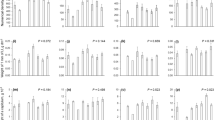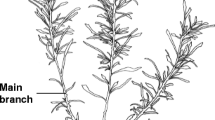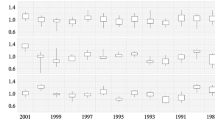Abstract
The linear increment of Sphagnum fuscum and S. magellanicum in ombrotrophic mires of Western Siberia has been measured during two years over a transect about 2500 km long extending from forest–steppe to forest–tundra. Along the latitudinal gradient, the increment of both species has proved to be correlated with annual average air temperature and, in S. magellanicum, also with annual precipitation. The determinants of their growth differ between the southern, central, and northern parts of the study region. At the regional level, the annual and summer precipitation plays a more important role than the average air temperature. The increment of S. fuscum in the southern part is positively correlated with the amount of precipitation and negatively correlated with summer temperature, whereas the situation in the central part is inverse. In S. magellanicum, the linear increment is directly dependent on the annual average temperature and annual and summer precipitation in the south and on the annual and summer precipitation in the north of Western Siberia. The dynamics of linear growth of both species in bog pine forests during the growing season are similar: its rate is the highest in June, when the linear increment of S. fuscum and S. magellanicum amounts to 60 and 85% of the annual total, respectively.
Similar content being viewed by others
References
Liss, O.L., Abramova, L.I., Avertov, N.A., et al., Bolotnye sistemy Zapadnoi Sibiri i ikh prirodookhrannoe znachenie (Bog Systems of Western Siberia and Their Significance for Nature Conservation), Tula: Grif i Ko, 2001.
Hájek, T., Habitat and species controls on Sphagnum production and decomposition in a mountain raised bog, Boreal Environ. Res., 2009, no. 14, pp. 947–958.
P’yavchenko, N.I., On the productivity of Western Siberian Bogs, Rastit. Resur., 1967, vol. 3, no. 4, pp. 523–533.
Glebov, F.Z., Vzaimootnosheniya lesa i bolota v taezhnoi zone (Forest–Bog Relationships in the Taiga Zone), Novosibirsk: Nauka, 1988.
Maksimov, A.I., On the growth increment of Sphagnum mosses, in Kompleksnoe issledovanie rastitel’nosti bolot Karelii (Integrated Studies on the Vegetation of Karelian Bogs), Petrozavodsk, 1982, pp. 170–179.
Luken, J.O., Zonation of sphagnum mosses: Interactions among shoot, growth, growth form, and water balance, The Bryologist, 1985, no. 88, pp. 374–379.
Wallen, B., Falkengren-Grerup, U., and Malmer, N., Biomass, productivity and relative rate of photosynthesis of Sphagnum at different water level on a South Swedish peat bog, Holarct. Ecol., 1988, no. 11, pp. 70–76.
Robroek, B.J.M., Limpens, J., Breeuwer, A., and Schouten, M.G.C., Effects of water level and temperature on performance of four Sphagnum mosses, Plant Ecol., 2007, no. 190, pp. 97–107.
Grabovik, S.I., Effect of climatic conditions on the linear increment of Sphagnum mosses in southern Karelia, Rastit. Resur., 2000, vol. 36, no. 2, pp. 62–68.
Grabovik, S.I., Dynamics of annual increment in some species of Sphagnum L. in different bog complexes of southern Karelia, Rastit. Resur., 2002, vol. 38, no. 4, pp. 62–68.
Grabovik, S.I., Dynamics of annual increment in some species of Sphagnum L. in different bog complexes of southern Karelia, Rastit. Resur., 2002, vol. 38, no. 4, pp. 62–68.
Gunnarsson, U., Global patterns of Sphagnum productivity, The Bryologist, 2005, no. 27, pp. 269–279.
Loisel, J., Gallego-Sala, A.V., and Yu, Z., Global-scale pattern of peatland Sphagnum growth driven by photosynthetically active radiation and growing season length, Biogeosciences, 2012, no. 9, pp. 2737–2746.
Kosykh, N.P. and Koronatova, N.G., Changes in the linear increment and production of two Sphagnum species along a latitudinal gradient, Torfyaniki Zapadnoi Sibiri i tsikl ugleroda: proshloe i nastoyashchee: Mat-ly IVmezhdunar. polevogo simpoziuma (Peatlands of Western Siberia and Carbon Cycle: The Past and Present. Proc. IV Int. Field Symp.), Tomsk: Tomsk, 2014, pp. 186–188.
Titlyanova, A.A., Kosykh, N.P., and Mironycheva-Tokareva, N.P., Increment of bog plants, Sib. Ekol. Zh., 2000, no. 5, pp. 653–658.
Kosykh, N.P., Mironycheva-Tokareva, N.P., Peregon, A.M., and Parshina, E.K., Net primary production in peatlands of middle taiga region in Western Siberia, Russ. J. Ecol., 2008, vol. 39, no. 7, pp. 466–474.
Moore, T.R., Growth and net production of Sphagnum at five fen sites, subarctic eastern Canada, Can. J. Bot., 1989, no. 67, pp. 1203–1207.
Weltzin, J.F., Harth, C., Bridgham, S.D., Pastor, J., and Vonderharr, M., Production and microtopography of bog bryophytes: Response to warming and watertable manipulations, Oecologia, 2001, no. 128, pp. 557–565.
Breeuwer, A., Heijmans, M.M.P.D., Robroek, B.J.M., and Berendse, F., The effect of temperature on growth and competition between Sphagnum species, Oecologia, 2008, no. 156, pp. 155–167.
Grabovik, Sv. and Nazarova, L., Linear increment of Sphagnum mosses on Karelian mires (Russia), Arctoa, 2013, no. 22, pp. 1–4.
Waddington, J.M., Rochefort, L., and Campeau, S., Sphagnum production and decomposition in a restored cutover peatland, Wetl. Ecol. Manag., 2003, no. 11, pp. 85–95.
Clymo, R.S., The growth of Sphagnum: Methods of measurement, J. Ecol., 1970, no. 1, pp. 13–50.
Raspisanie pogody: bank dannykh (Weather Databank), St. Petersburg, 2004. https://rp5.ru.
Makhatkov, I.D. and Ermolov, Yu.V., Specific features of thermal regime in permafrost and thawed mires, Ekologiya i prirodopol’zovanie v Yugre: Mat-ly vseros. nauch.-prakt. konf., posvyashch. 15-letiyu kafedry ekologii SurGU (Ecology and Nature Research Management in Yugra: Proc. Sci.-Pract. Conf. Dedicated to the 15th Anniversary of the Department of Ecology, Surgut State Univ.), Surgut: Surgut. Gos. Univ., 2014, p. 69.
Author information
Authors and Affiliations
Corresponding author
Additional information
Original Russian Text © N.P. Kosykh, N.G. Koronatova, G. Granath, 2017, published in Ekologiya, 2017, No. 3, pp. 161–170.
Rights and permissions
About this article
Cite this article
Kosykh, N.P., Koronatova, N.G. & Granath, G. Effect of temperature and precipitation on linear increment of Sphagnum fuscum and S. magellanicum in Western Siberia. Russ J Ecol 48, 203–211 (2017). https://doi.org/10.1134/S1067413617030080
Received:
Published:
Issue Date:
DOI: https://doi.org/10.1134/S1067413617030080




